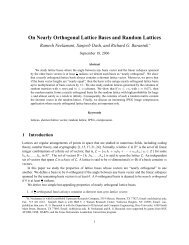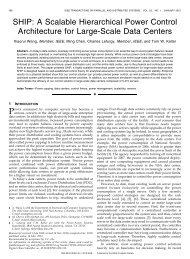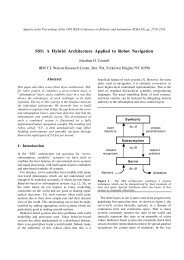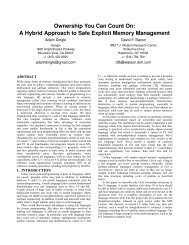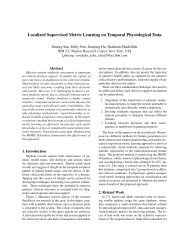Design and Implementation of a Homomorphic ... - Researcher
Design and Implementation of a Homomorphic ... - Researcher
Design and Implementation of a Homomorphic ... - Researcher
Create successful ePaper yourself
Turn your PDF publications into a flip-book with our unique Google optimized e-Paper software.
all the a i ’s are derived. The b i ’s are stored explicitly, however. We note that this space-efficient<br />
representation requires that we assume hardness <strong>of</strong> our ring-LWE instances even when the seed for<br />
generating the r<strong>and</strong>om elements is known, but this seems like a reasonable assumption.<br />
In our library, the source secret key s ′ is <strong>of</strong> the form s ′ = si r (X t ) (for some index i ′ <strong>and</strong><br />
′<br />
exponents r, t), but the target s must be a “base” secret-key, i.e. s = s i (X) for some index i. The<br />
KeySwitch object stores in addition to the matrix W also a secret-key h<strong>and</strong>le (r, t, i ′ ) that identifies<br />
the source secret key, as well as the index i <strong>of</strong> the target secret key.<br />
The KeySwitch class provides a method NumCols() that returns the number <strong>of</strong> columns in the<br />
matrix W . We maintain the invariant that all the key-switching matrices that are defined relative<br />
to some context have the same number <strong>of</strong> columns, which is also equal to the number <strong>of</strong> digits that<br />
are specified in the context.<br />
3.2.2 The FHEPubKey class<br />
An FHEPubKey object is defined relative to a fixed FHEcontext, which must be supplied to the<br />
constructor <strong>and</strong> cannot be changed later. An FHEPubKey includes the public encryption key<br />
(which is a ciphertext <strong>of</strong> type Ctxt), a vector <strong>of</strong> key-switching matrices (<strong>of</strong> type KeySwitch), <strong>and</strong><br />
another data structure (called keySwitchMap) that is meant to help finding the right key-switching<br />
matrices to use for automorphisms (see a more detailed description below). In addition, for every<br />
secret key in this instance, the FHEPubKey object stores the Hamming weight <strong>of</strong> that key, i.e., the<br />
number <strong>of</strong> non-zero coefficients <strong>of</strong> the secret-key polynomial. (This last piece <strong>of</strong> information is used<br />
to compute the estimated noise in a ciphertext.) The FHEPubKey class provides an encryption<br />
method, <strong>and</strong> various methods to find <strong>and</strong> access key-switching matrices.<br />
long Encrypt(Ctxt& ciphertxt, const ZZX& plaintxt, long ptxtSpace=0) const; This method<br />
returns in ciphertxt an encryption <strong>of</strong> the plaintext polynomial plaintxt, relative to the plaintextspace<br />
modulus given in ptxtSpace. If the ptxtSpace parameter is not specified then we use the<br />
plaintext-space modulus from the public encryption key in this FHEPubKey object, <strong>and</strong> otherwise<br />
we use the greater common divisor (GCD) <strong>of</strong> the specified value <strong>and</strong> the one from the public<br />
encryption key. The current-modulus in the new fresh ciphertext is the product <strong>of</strong> all the ciphertextprimes<br />
in the context, which is the same as the current modulus in the public encryption key in<br />
this FHEPubKey object.<br />
Let the public encryption key in the FHEPubKey object be denoted ⃗c ∗ = (c ∗ 0 , c∗ 1 ), let Q ct be<br />
the product <strong>of</strong> all the ciphertext primes in the context, <strong>and</strong> let p be the plaintext-space modulus<br />
(namely the GCD <strong>of</strong> the parameter ptxtSpace <strong>and</strong> the plaintext-space modulus from the public<br />
encryption key). The Encrypt method chooses a r<strong>and</strong>om low-norm polynomial r ∈ A Qct with<br />
−1/0/1 coefficients, <strong>and</strong> low-norm error polynomials e 0 , e 1 ∈ A Q , where each coefficient <strong>of</strong> e i ’s is<br />
chosen from a discrete Gaussian over the integers with variance σ 2 (with σ a parameter, by default<br />
σ = 3.2). We then compute <strong>and</strong> return the canonical ciphertext<br />
⃗c = (c 0 , c 1 ) := r · (c ∗ 0, c ∗ 1) + p · (e 0 , e 1 ) + plaintxt.<br />
= p · e ∗ for some low-norm poly-<br />
Note that since the public encryption key satisfies [c ∗ 0 + s · c∗ 1 ] Q ct<br />
nomial e ∗ , then we have<br />
[c 0 + s · c 1 ] Qct = [r · (c ∗ 0 + s · c ∗ 1) + p · (e 0 + s · e 1 ) + plaintxt] Qct<br />
= p · (e 0 + s · e 1 + r · e ∗ ) + plaintxt.<br />
25




